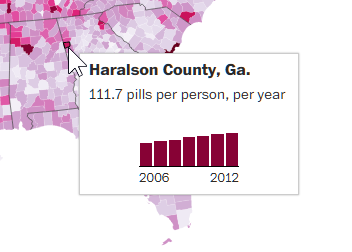Bee sting vaccine, scary opioid stats, hug a cat today, and more
18 Jul 2019
Posted by Andrew Kantor
Opioids: DEA releases new, scary stats
After pressure from the Washington Post and the Charleston (W.Va.) Gazette-Mail, a federal judge in Ohio ordered the DEA to release it’s database “that tracks the path of every single pain pill sold in the United States
— from manufacturers and distributors to pharmacies in every town and city.”
It is a treasure trove of information, and it makes clear exactly where these drugs were coming from and where they were going. And because it’s hard data from the companies themselves as reported to the DEA, there’s no way to dispute the figures.
And they are huge.
The numbers of pills the companies sold during the seven-year time frame are staggering, far exceeding what has been previously disclosed in limited court filings and news stories.
In just six years, the two largest manufacturers produced more than 55 billion pills. In total, more than 76 billion were produced.
In 2012 — that was seven years ago! — more than 12.6 billion were distributed; Haralson County, Georgia, received an average of 112 pills per person every year. (Click here to check out all the data.)

And with more Americans dying from opioid overdoses every year than were killed in the entire Vietnam War… well, you can bet this isn’t the last we’ll be hearing about it.
How’s your workload?
GPhA member Jonathan Hamrick needs your help with a research study on pharmacist workload. Can you give the guy a hand?
Calling pharmacists in Georgia. I am conducting a research study about pharmacist workload and its correlation with patient outcomes. If you would be interested in taking this survey, please click here.
If you have any questions about the study, contact Johnathan — he’s the principal investigator — at (678) 547-6245, or by e-mail to hamrick_jw@mercer.edu.
Peach State Health Plan is transitioning
Specifically from CVS Caremark to RxAdvance as the claims processor and pharmacy contractor. If you thought, “Oh, I should note that,” you might want to click here for some more info — a PDF with the deets.
Menstrual cups make a comeback
They’re an alternative to tampons or pads, they’re less expensive, and, as a new study in The Lancet just concluded, they’re safe and effective — more effective than disposable products, in fact. Oh, and they can last 10 years. (That link was to the news article. Prefer the study? Click here.)
Hair of the dog
Although marijuana isn’t typically addictive, some people can show signs of dependence. Now a new study reported in JAMA Internal Medicine finds that a new medicine — itself a cannabinoid — can reduce the cravings for marijuana.
“The principles are very similar to nicotine replacement; you are providing patients with a medicine, which is safer than the drug they’re already using, and linking this with medical and counseling support to help people address their illicit cannabis use.”
Fur of the cat
Feeling stressed? Hug a cat. Or a dog. Washington State University scientists have proven that just 10 minutes of cuddle time with a dog or can cut down the stress.
“Students in our study that interacted with cats and dogs had a significant reduction in cortisol, a major stress hormone.”

Elsewhere: Down Under
In Australia — where bees are (we assume) the size of minivans with stingers that would take down Moby Dick — they’ve successfully completed a human trial on a vaccine against bee-sting reactions. It essentially helps the body fight off the toxin fast enough to preclude a deadly reaction.


